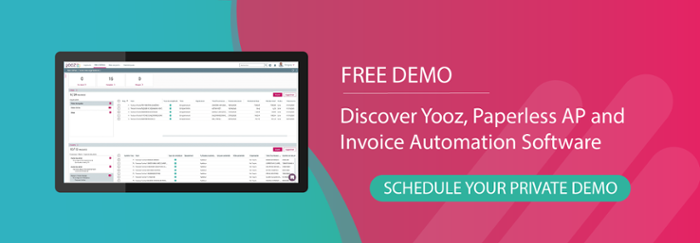Whether you are a small business or large, managing the Accounts Payable process is crucial to running a business. Accounts Payable (AP) refers to the money that a company owes to suppliers or vendors for goods or services received but not yet paid for. An effective AP process ensures that Purchase Orders (POs) are submitted accurately, invoices are received and processed quickly, and suppliers get paid on time. In the past the Accounts Payable process was handled manually however thanks to automation technology, managing these procedures can now be done much faster and with more ease, efficiency, and accuracy.
Here we'll look at Accounts Payable automation, including how it can help organizations to optimize their cash flow as well as the tools and technology that can help streamline your AP workflow.

What Is the Accounts Payable Process?
Every time that your organization makes a purchase, the amount that you owe is added to your Accounts Payable balance and recorded as a liability on the organization's balance sheet.. The Accounts Payable process refers to the set of guidelines and tasks involved in managing and paying the bills and invoices that a business owes to its suppliers or vendors. The process typically involves several steps, such as verifying information on the vendor invoice, entering data into the accounting system, obtaining payment approval, and issuing payments.
An effective, streamlined Accounts Payable process ensures that vendor payments are sent and received as efficiently as possible.
Examples Of Accounts Payable Expenses
AP expenses are what a business owes to its vendors, suppliers, or creditors for goods or services it has received but not yet paid for. For example:
- Leasing office space or equipment
- Raw materials and other inventory purchases
- Transportation and logistics
- Products and equipment
- Utilities such as gas, electricity, and water
- Professional services such as consulting or legal fees
- Repairs and maintenance of buildings, equipment, and vehicles
- Insurance for equipment, property, employer liability, or workers' compensation
- Marketing and advertising.
Once payment for these expenses is made in full, the line item and expense is removed from the Accounts Payable account and recorded as a cash outflow on the company's financial statements.
Importance Of Vendor Management For Accounting Success
Proper management of the AP process is critical for maintaining good relationships with suppliers, avoiding late fees and penalties, and ensuring accurate financial reporting. However, for the processes to be effective, the organization also requires good vendor management including accurate, up-to-date vendor information. A solid relationship with your vendors can minimize payment errors, improve pricing and ensure prompt delivery of goods and services.
What Are The Key Steps In The Accounts Payable Process?
The Accounts Payable process features several key steps that can affect a business's financial health. These steps include:
- Submitting a purchase order to the vendor or supplier
- The vendor or supplier confirms whether they can supply the product or service required, fulfills the order, and sends a bill or invoice to the organization
- When the supplier invoices are received, the invoice data is cross referenced to ensure the goods and services received correspond with what was actually ordered and that there are no fraudulent invoices or duplicate payments being requested.
- The designated manager approves the invoice before the payments owed are processed
- Once approved, payment is sent to the vendor or supplier. The finance department should then reconcile invoices and payments to ensure accuracy.
Following these steps can help ensure there is sufficient cash flow, track expenses and ensure compliance with regulatory requirements, improve relationships with vendors, and even assist with preparing financial statements and tax returns.

The Relationship Between Cash Flow And Accounts Payable
If the organization has a high level of Accounts Payable, it owes a significant amount of money to its vendors and suppliers. This can adversely impact cash flow as the organization will need to meet these payments in the future. If the organization lacks sufficient cash flow to cover these payments, it may struggle to pay its bills, which can seriously impact vendor relationships and even have legal consequences.
On the other hand, if the organization has a low level of Accounts Payable, meaning it owes less money, this can enhance cash flow as the organization has fewer payment obligations. Therefore it is to the business's benefit and long-term financial health to optimize their cash flow by streamlining the invoice processing and payment workflow. This can be done through AP automation.
What Are Standard Accounts Payable Procedures and Why Every Business Should Care
While AP processes refer to the steps involved in managing and recording a company's financial obligations to its vendors and suppliers - the actual tasks that need to be carried out - AP procedures are the documented instructions that govern how the payable team these processes are carried out. AP procedures also provide guidance on the tools and systems used to perform the processes.
That said, there are several AP procedures that businesses should follow to ensure accuracy, efficiency, and compliance with all relevant accounting standards and regulations.
Establish An Accounts Payable Policy
Create a policy summarizing the company's accounts payable process, including the correct procedures for receiving invoices, reviewing and approving invoices, payment terms, and communicating with vendors. All employees and vendors should know about this policy to ensure overall compliance.
Invoice Verification
All invoices that come in should be matched with the correct purchase order for goods received, including the unit price, order quantity, and total invoice amount.
Invoice Approval
Establish an efficient invoice approval system encompassing review and approval by authorized staff.
Payment Processing
Implement a payment processing system to confirm the payment amount is accurate and that the payment is processed within the previously agreed terms.
Vendor Management
Create a system for managing vendor relationships, including regular communications, monitoring vendor performance, and identifying and resolving issues.
Month-end Closing
Perform a monthly review of all accounts payable transactions and reconcile them with vendor statements to ensure transactions are recorded properly, and the accounts payable balance is accurate.
Tools and Technologies Available To Streamline Accounts Payable
Several tools and technologies are now available to help organizations streamline the accounts payable process and here are some examples.
Accounts Payable Automation
Accounts Payable automation reduces the need for manual data entry, minimizes errors, and speeds up the overall approval process. It can also provide real-time visibility into payment status, helping organizations identify potential issues and improvement opportunities.
Electronic Invoice Presentment And Payment (EIPP)
EIPP lets vendors submit invoices and receive payments electronically, helping to speed up the process and avoid errors.
Purchase Order (PO) Automation
PO Automation automates creating, approving, and reconciling purchase orders, invoices, and receipts to streamline the purchase order process.
Payment Processing
Various payment processing tools are available to help automate the payment process, such as electronic payment options like ACH (Automated Clearing House) transfers and virtual credit cards.
How To Improve Your Accounts Payable Procedures To Increase Efficiency And Reduce Errors
If you want to improve your organization's accounts payable procedures and increase efficiency and accuracy, here are some best practices to implement.
Adopt An Electronic Accounts Payable System
Electronic accounts payable systems can automate invoice receipts, payment, and reconciliation processing and reduce the need for manual data entry, significantly improving efficiency and reducing processing time and the risk of errors.
Create Clear Policies And Procedures
Establish thorough Accounts Payable processing policies and procedures to encompass invoice receipt, review and approval processes, payment terms, and vendor communication.
Introduce Internal Controls
Ensure robust internal controls to reduce errors and fraud by separating duties across different employees, establishing invoice and payment approval procedures, and conducting regular transaction reviews.
Streamline Invoice Processing
Invest in streamlined invoice processing that includes confirming accuracy, reconciliation, and obtaining appropriate approvals before payment.
Use Data Analytics
You can use data analytics to identify areas within the accounts payable process requiring improvement, such as payment accuracy, invoice processing time, and vendor performance.

What Are Best Practices for Mastering the Accounts Payable Process?
Here are 7 best practices for companies to follow that will help master their AP processes, minimize errors and fraud, and ensure on-time invoice payments:
- Establish clear policies and procedures. This ensures that everyone involved knows what is expected of them and helps to ensure consistency and accuracy.
- Use technology. Implementing technology solutions like AP automation software can help streamline the AP process, reducing the risk of errors and delays and improving efficiency.
- Maintain accurate records. It is vital to keep and maintain accurate and up-to-date records of all AP transactions, including invoices, payments, and receipts.
- Monitor cash flow. Keeping an eye on the available cash is crucial to ensure that there is enough cash available tp pay invoices when they come due.
- Implement segregation of duties. Segregation of duties is essential to prevent fraud and error from occurring. It involves assigning different tasks to different people to ensure that no one person has too much control over the entire financial process.
- Monitor and analyze metrics. Measuring and analyzing metrics - the number of invoices processed over a certain period, the time required to process invoices, etc. - can help identify areas for improvement.
- Regularly review vendor contracts. Regularly reviewing vendor contracts ensures that the terms and conditions are up-to-date and that the company is getting the best value for their money.
What Are The Best Practices For Maintaining Accurate Records And Ensuring Compliance With Regulatory Requirements?
Accounting procedures must comply with several regulatory requirements, including labor laws, tax, and industry-specific standards. The consequences of failing to comply with regulations can be severe, including substantial financial penalties, prosecution, and reputational damage. Here are some best practices to help achieve compliance:
- Implement clear record-keeping procedures
- Use secure and reliable record-keeping systems
- Ensure all transactions and financial activities are properly documented
- Train employees on record-keeping requirements and compliance
- Keep updated with changes to laws and regulations
- Liaise with legal experts or regulatory professionals as required.
What Can We Conclude?
In summary we can conclude that mastering Accounts Payable processes is critical for businesses of all sizes. Having a streamlined AP process ensures that purchase orders are submitted accurately, invoices are processed quickly, and suppliers are paid on time. A key factor in accomplishing this is to establish standard AP procedures that ensure accuracy, efficiency, and compliance with all accounting standards and regulations.
While all of these are things that can be handled manually, implementing an AP automation system is one of the best ways to optimize your company's cash flow.
Enhance Your Accounts Payable Processes Today With Yooz
If you want to simplify your invoice processes, save time and money, and eliminate errors, contact Yooz today to learn how we can transform your accounts payable procedures and help your business thrive.







